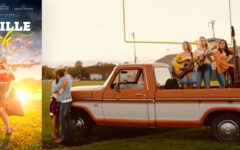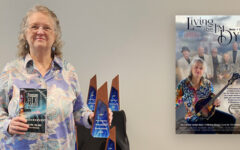
A new Julia Golonka film about IBMA Hall of Fame member Hazel Dickens takes its title from Dickens’ powerful anthem Don’t Put Her Down, You Helped Put Her There, and explores how she, along with her musical partner Alice Gerrard, became the first women to front a bluegrass band, and reflects on the role of women in bluegrass today.
The short film – 32 minutes long – covers Hazel’s migration to Baltimore from coal country West Virginia, her activism for coal miners and working people, and the impact her upbringing had on her song writing. Lifelong collaborators and up-and-coming musicians share what it means to have bluegrass songs written from a woman’s point of view, and keep Hazel’s memory alive.
Golonka provides this background information …
“Until I came across the music of Hazel Dickens, I had not realized that up to that point I was primarily listening to men play bluegrass. I was listening to a playlist of covers of Long Black Veil, and when Hazel and Alice’s version came on, I was absolutely struck by her voice. I then found the Pioneering Women of Bluegrass album, and that’s when I really dove into her music. I was talking to a musician friend about her, and he mentioned that her nephew Buddy lives in Baltimore and is active in the music scene. I met up with Buddy in early 2017 and proposed my idea for this film and he was very supportive, and I finished the film in December 2021. Hazel and Alice were inducted to the Bluegrass Hall of Fame in the fall of 2017, and that was the first big shoot I did for the film. I didn’t end up using any of the ceremony footage in the end, but it was still so inspiring to be there and see how many people have been touched by Hazel’s music.
After that shoot, I was filming with Hazel’s nephew Buddy and a few Baltimore-based musicians, and learning more about Hazel, and I really got going on the film in 2019. I was accepted to be a fellow at the Saul Zaentz Innovation Fund at Johns Hopkins with this project, and that provided me with storytelling workshops, feedback, a great editing mentor who was familiar with Hazel’s music, and then I also received funding for the film from SZIF. This funding was absolutely essential and made the film possible. In the time that I was working on this film, I ended up having a lot more opportunities for shoots than I thought I would! I thought I would mostly be filming interviews and working with archival content, but multiple events came up throughout the last few years – Hazel and Alice inducted to the Bluegrass Hall of Fame, Hazel’s induction to the Blue Ridge Music Hall of Fame, the release of Sing Me Back Home: The DC Tapes, and the dedication of the Hazel Dickens Memorial Bridge. The fact that Hazel continues to get honored in the years after her death made me feel like this is a relevant time to make this film, and that the audience of Hazel fans is still growing.
One shoot that stands out was going down to her hometown of Montcalm, West Virginia, to film the dedication of the Hazel Dickens Memorial Bridge on her birthday in 2019. Her nephew Buddy took us (myself and a production/camera assistant) to a jam with musicians that had played with Hazel, we heard stories from them, and we visited her grave. The film ends with the bridge dedication ceremony, which felt like the most beautiful way to honor her since so many of her songs are about home.
The film features interviews with Ginny Hawker, Dudley Connell, Ketch Secor, Karen Collins, Molly Tuttle, Avery Hellman, Tom Gray, and Buddy Dickens.
Throughout the film, scenes from Hazel’s life play out on a Crankie, a hand-scrolled panorama featuring cut paper and shadow puppetry. Since my film is a story about the past that looks towards the future, I was drawn to using this archaic form of storytelling and presenting it in a digital way. Baltimore has a very active Crankie scene, and I worked with papercut artist Katherine Fahey to create the Crankies for my film. There is one long Crankie scene in the film where Lost Patterns plays in its entirety, and that’s the only full song of Hazel’s we hear. I chose this song because Hazel mentions that she is most proud of her song writing, and that this song is one she is especially proud of.”
Some forthcoming showings ..
Albuquerque Film + Music Experience – Friday, September 16, 2022, 9:30am, NHCC – Wells Fargo Theatre, 1701 4th St. SW, Albuquerque, New Mexico 87102, (in-person screening) and through to November 18, 2022 (for online viewing) [this is the only virtual option currently scheduled)
Hardly Strictly Bluegrass – Friday, September 30, 2022. 7:30pm, Hardly Strictly Out of the Park, Sweetwater Music Hall, 19 Corte Madera Avenue, Mill Valley, California 94941
New Haven Documentary Film Festival – Saturday, October 22, 2022, 4:00 p.m., Bow-Tie Criterion Cinemas – Screening Room 8, 86 Temple Street, New Haven, Connecticut 06510
Reading Film Fest, Reading, Pennsylvania – Sunday, October 30, 2022, GoggleWorks Center for the Arts, Boscov Theater, 201 Washington Street, Reading, Pennsylvania 19601
To sign up for notifications regarding other screenings contact Julia Golonka, visit her web site.
Film Credits
- Director / Producer: Julia Golonka
- Assistant Editor: Madeline Becker
- Consulting Editor: Kirsten Hollander
- Director of Photography: Michael O’Leary, Julia Golonka
- Composer: Connor Vance
- Audio Engineer: Tim St. Clair
- Archival Assistant: Clara Rieldinger
Hazel Dickens was born in Montcalm, Mercer County, West Virginia, on June 1, 1925, the eighth of eleven siblings in a mining family of six boys and five girls.
She was a bluegrass music pioneer – one of the first women to front a bluegrass band – and a songwriter who wrote of coal miners, unionization, hard times and feminism, among other topics.
During her lifetime, Dickens received many awards for her contributions to music. She was the first woman to receive an Award of Merit from the International Bluegrass Music Association (IBMA) in 1993 for contributions to bluegrass music. In 1995 Dickens was inducted into the Society for the Preservation of Bluegrass Music Association’s Hall of Greats and three years later she was named Traditional Female Vocalist award in the Washington D.C. area’s WAMMIE® Awards.
Notable among them are a 2001 National Heritage Fellowship and a 2008 National Heritage Award from the National Endowment for the Arts and a Lifetime Achievement Award in 2002 from what is now Folk Alliance International.
She was among the first inductees into the West Virginia Music Hall of Fame in 2007.
The DC Bluegrass Union established the Hazel Dickens Songwriting Contest in her name.
Julia Golonka is an editor and cinematographer with a degree in film from the Maryland Institute College of Art. She has worked on several feature-length documentaries, including Anatomy of Wings and It’s Not Who I Am. She specializes in music cinematography.
Her work has been featured online by Rolling Stone, Relix and Bluegrass Today.







